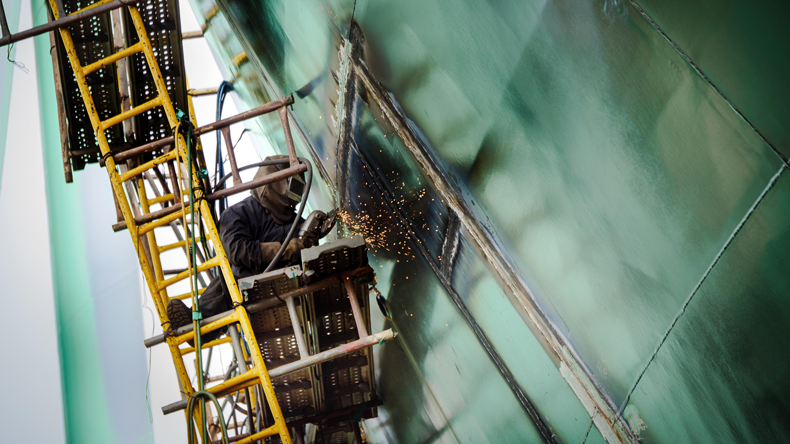



Despite a regulatory push to decarbonise, some 24% of vessels (by gross tonnage) in the global fleet are configured to burn higher-sulphur fuel oil, with more coming into operation
There have been 220 ships ordered this year that will have scrubbers fitted upon delivery. This compares with 200 ships on the orderbook that will use alternative fuels, such as methanol

Source: Mike Gorsky / Alamy Stock Photo
NEARLY 30% OF SHIPS ON ORDER AT YARDS WORLDWIDE ARE SET TO USE LIQUEFIED NATURAL GAS AS A MARINE FUEL.
THERE are more newbuilding ships ordered this year that will have scrubbers installed to burn high-sulphur fuel oil than there are orders placed for vessels to consume alternative fuels, analysis shows.
Despite the regulatory push to decarbonise the global fleet, there are already eight times more vessels on the water fitted with scrubbers that allow them to burn 3.5% sulphur fuel oil than there are units on the orderbook for liquefied natural gas-powered ships, according to figures from Clarksons.
About 220 ships ordered in 2021 specified scrubbers would be fitted to use HSFO, the dirtiest and cheapest fuel oil on the market. Global regulations switched marine fuel oil to 0.5% sulphur from 3.5% sulphur on January 1, 2020, unless ships have scrubbers installed.
LNG-powered ships are said to reduce carbon emissions by 20%, although this figure has been disputed by some observers and the scale of any benefits depends on engine type.
Ships on the water that were already using the sulphur abatement technology comprised 4,541 units, or 24% of the global fleet when measured by gross tonnage, the report said. Of newbuilding orders reported in 2021, 186 of the 220 reported to be scrubber-ready were containerships.
That compares with orders for 200 ships on Clarksons database that will use alternative fuels or propulsion including methanol (22 ships), ethane (10), hydrogen (3) and battery/hybrid propulsion (150), the report said.
Nearly 30% of ships on order at yards worldwide are set to use LNG as a marine fuel, according to the analysis on the uptake of alternative fuels.
Regulatory and policy changes to cut vessel emissions are ramping up across the maritime sector, which has focused attention on the uptake of new technology and fleet renewal trends, the research arm of the world’s biggest shipbrokers said.
There are 546 units, or 29.7% of the orderbook as measured by gross tonnage, set to use LNG, with another 95 being built to use liquefied petroleum gas.
In all, 200 ordered vessels will have alternative fuels or propulsion, including methanol (22 ships), ethane (10), hydrogen (3) and battery or hybrid propulsion (150).
Battery or hybrid propulsion is being used for smaller ferries and passenger vessels.
The orderbook included 95 units that were designated ‘LNG ready’, while there were 24 ‘ammonia-ready’ and five ‘hydrogen-ready’ vessels on order.
All up, some 4.2% of ships on water now use alternative fuels — which includes LNG even though it is a fossil fuel — over conventional marine fuel oils, the Clarksons figures showed.
International shipping is responsible for 3% of the world’s carbon emissions, which must be cut by at least half by 2050, with carbon energy intensity reduced by 40% by 2030.
There is much uncertainty about the transition’s pace and scale because much of the zero-emission fuel technology, such as ammonia, is unproven. What is more, there are limited or no supplies of alternative fuels available.
The global fleet also has to comply with new technical measurements contained in an Energy Efficiency Index for Existing ships, known as EEXI, and a Carbon Intensity Indicator called CII.
The metrics calculate carbon emissions based on service speed, design speed and deadweight and will change many elements of fleet operations, such as how vessels are chartered, as well as sailing speeds.
Clarksons said that energy-saving technologies have been fitted on 4,259 ships, accounting for 20.4% of fleet tonnage. These included propeller ducts, rudder bulbs, Flettner rotors, wind kites and air lubrication systems for hulls.
Port infrastructure to serve a network of alternative fuels was expanding, the report said.
There were 141 active LNG bunkering ports, with a further 95 planned, while another 1,086 ships were being fitted with or planned to fit shore-power connections. Shore-power connections will be required under the European Union’s Fit for 55 greenhouse gas emissions plan for the maritime sector.